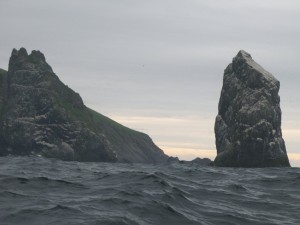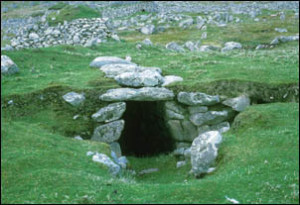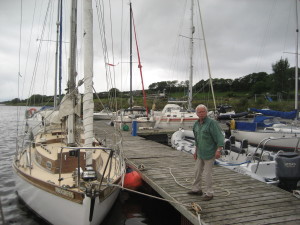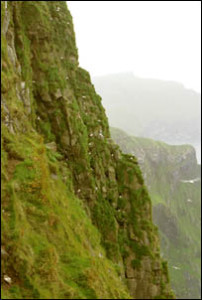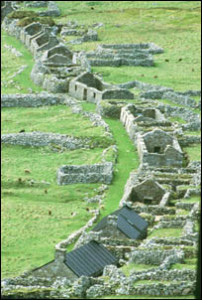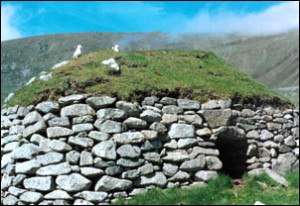
The lonely cliffs of St. Kilda
Voyaging to these abandoned Atlantic islands
STORY AND PHOTOS BY JOE GASTON (ghost-written for Joe by Steve Coleman) reprinted from OCEAN NAVIGATOR magazine Nov/Dec 2012
One of the few buildings on St. Kilda overlooks Village Bay on the island of Hirta.
After retiring from my Northern Ireland medical practice at the age of 60, I devoted myself to ocean voyaging. Aboard Progress, my 34-foot wooden hull sloop of 1950’s vintage, I explored on both sides of the North Atlantic. One of my fondest memories, however, is a relatively modest four-day cruise to the islands of St. Kilda far to the west of Scotland.
Sailing the Atlantic above the Emerald Isle can be quite a challenge — even to those of us Irishmen who regularly sail our northern coast. An endless stream of high- and low-pressure systems moving in from the west create ever-changing weather. Conditions range from storms to bright sunshine, and blows to Force 5 to 7 are not uncommon even in the summer.
Dr. Joe Gaston with his 34-foot wooden sloop Progress at its dock on the River Bann.
A great part of the allure of St. Kilda is due to the islands’ remote location. They are a group of small islands — mainly the tops of volcanic mountains rising steeply out of the sea. The archipelago lies about 50 miles west of the westernmost Scottish Hebrides, and approximately 180 miles across open sea from Ireland. Affording a remote destination for my boat, I decided it would be a trip worth taking.
A traditional approach
With three-and-a-half tons of cast iron in its keel and a five-foot, eight-inch draft, my boat is a seaworthy one. I describe it as “seakindly,” meaning that its hefty design provides a smoother ride than more modern lighter weight boats. Even so, an extended sail aboard Progress would give a lot of modern-thinking mariners second thoughts about going. There is no refrigerator and no freezer and the only interior illumination is provided by several oil lanterns. Showers are taken on deck under a Sun Shower. The boat carries 55 gallons of fresh water and 30 gallons of diesel fuel, and sleeping space for four includes one bunk where the sleeper must stick his legs through a cut-out in the bulkhead. This was a common feature in boats of older vintage and in this part of the world is known, for some mysterious reason, as a “trotter box.”
Beyond the question of comfort for crew, however, is the matter of finding people who share not only a sense of adventure, but also my attitudes and motives for sailing, if I’m to get everyone pulling together. On this cruise, I found I had enlisted two crew who, though old friends, were sometimes at cross purposes with me.
Progess’s route took them past Scotland’s Outer Hebrides to the rarely visited island group of St. Kilda.
I keep Progress at Seaton’s Marina, about three miles from the mouth of the River Bann (providing the best Salmon fishing In Ireland). Andy Seaton, the marina operator, decided not only to join us, but also brought his video camera along. Andy, who passed away in 2010, was a sound and knowledgeable sailor and one I would be pleased to take with me anywhere. Another crewmember was Pascal Eymere, a Frenchman who sailed from France to the River Bann one day, fell in love with the place and took up residence forever, establishing a business of exporting mutton and lamb from N. Ireland to France. The final crewman was Jimmy Dempsey, who owns an appliance store in nearby Portstewart. With this assembly of sailors, I was ready to go. What I did not expect was that two of my crew would find it hard to leave work and business concerns behind, and that would cause a couple of issues along the way.
Crew struggles to depart
Consulting the two major nautical weather reporting agencies, I learned that a large summertime high-pressure system was moving through the North Atlantic, giving us a window of good weather for at least a week. Wishing to depart at noon to catch the ebbing tide, Andy and I awaited the arrival of our two tardy companions. Despite several calls cajoling them to come on, neither seemed willing to pull away from the demands of business. Finally after 1800, the two straggled to the boat, still checking phones for last minute messages about possible sales. Realizing that they just didn’t understand the real priorities in life, I nevertheless instructed them to cast off immediately. Clearing the barmouth of River Bann, we set out on a northerly course for Barra, 100 miles away in the Hebrides. Sailing overnight we reached Barra’s Castlebay and anchored for a restful evening. With cell coverage from Scotland, workaholics Pascal and Jimmy were happily phoning away the night.
Voyages in these often treacherous waters evoked a story or two. Jimmy, dubbed “the demon helmsman” for his love of steering for hours on end, told of his previous — most unplanned — voyage to St. Kilda with a noted Ulster sailor, Ivan Campbell. In the seat-of-the-pants dead-reckoning days before GPS, they missed landfall on Rockall. While attempting to find their destination, they were averted further by a storm, which took them to St. Kilda. Managing to make it to safety in Hirta’s Village Bay and riding out the storm, they set out for Scotland, only to lose their rudder in heavy seas. Fortunately, a fisherman came upon them adrift and towed them 30 or 40 miles to Barra. In the spirit of those times, Jimmy said, the fisherman refused to take “even a ha’penny” for his troubles.
At first light the next morning, in the dominating high pressure which usually brings good weather, we four aboard Progress weighed anchor under sail and piloted past the rocks in Castlebay, entering the Sound of Barra. Taking first a tack toward Berneray, the southern-most island of the Hebrides, Pascal managed to make a couple more business calls on his cellphone, and then the signal faded and there was nothing left but for him to relax a bit. In a moderate sea, we sailed steadily northwest under dull rain clouds, across 70 miles of open, empty ocean toward St. Kilda.
The islands’ steep sides make landing impossible. The isolated rocky outcroppings are called “stacks.”
Giant stacks
It was not until the gray light of evening that we first glimpsed land. Looming in the mist, the giant stacks of St. Kilda rose startlingly 1,000 feet and more above the deep ocean, rolling waves crashing on the sheer rock cliffs. The sight of them made the hair stand up on the back of my neck. All around Progress were pelagic birds, circling, soaring, diving for schools of small mackerel and cod that teem the waters. There are 40,000 pairs of white gannets with their yellow heads and six-foot span, black-tipped wings. Annually an estimated 1,000,000 puffins arrive to hatch their young on the cliffs. This stark archipelago creates its own weather with winds howling between needle-like stacks. Banks of rain-filled clouds scrape through the stacks, whipping our sails and straining the sheets. The island called Boreray cast the jagged silhouette of a huge dragon standing 1,245 feet above the sea. In 1879 British Yachtsman R.A. Smith came upon these islands and remarked, “Had it been a land of demons it could not have appeared more dreadful, and had we not heard of it before, we should have said that, if inhabited it must be by monsters.”
In twilight we arrived on the southern side of the big island, Hirta, and anchored in Village Bay, which affords a shallow, sandy bottom. It’s the only anchorage in the archipelago and is exposed to easterly winds and seas. Except for a weather-damaged bit of old concrete dock, there was no berthing to be had and there was no sign of people anywhere.
The next morning, we rowed our dingy into the small beach and explored the abandoned remains of the island culture that began well over 2,000 years ago. In the sloping valley above Village Bay, the Old Village houses are situated in a line curving along the contour of the land. Several hundred yards above is a stone wall fence running the length of the valley, built to keep their livestock out of the village and away from the garden plots located between the houses and the shore. The Gaelic speaking natives had kept both cattle and sheep that grazed above the rock fence. The sheep, a singular breed isolated here since the Bronze Age, are known as Soay sheep, so named for one of the islands that provides grass in a saddle-shaped strip of a few acres between two immense cliffs. Proof of the extreme isolation of the islands is a particular sub-species of mouse. And unique wrens have especially long claws for hanging on the cliffs in high winds.
Inspecting one of the ancient houses, I discovered that its exterior walls were seven feet thick, apparently designed to keep the 120-mph winter winds out. There were no windows and no chimney. The one-roomed houses had no interior walls, and fires of turf (not peat) were built in the center of the room, blackening the inside, hence the name “Black Houses” given to them. The cattle were brought inside during the winter to provide heat for the home. Outside, scattered about the community, are to be found about 1,000 “cleits” — small stone storehouses ventilated so that the harvested bird flesh could dry in the salty air. Freshwater hand-dug wells dotted the landscape.
Progress approaches the main island of Hirta.
The cattle were raised for milk and the sheep for wool (gathered by pulling the wool instead of shearing since the natives had no shears). But for food the people captured the pelagic birds and robbed their nests of eggs. Hiking up from the village, we climbed Conachair, the 1,410-foot mountain on Hirta, its cliff on the ocean side believed to be the highest sea cliff in Europe. The native St. Kildan men once rappelled barehanded and barefooted the treacherous rock cliffs to steal bird eggs. From the top of Conachair we could see soaring six-foot wing-spanned gannets, appearing only as mere dots of white against the dark blue sea below.
Even though the ocean around the islands teemed with fish, evidenced by the huge population of sea birds, the people of St. Kilda rarely ate fish. Without trees there was no wood to build boats and what few they had apparently were brought by rare visitors. So isolated for about 1,500 years, the people developed their own unique customs. Survival was a matter of communal cooperation, and what they had was divided equally among the families. To them time simply had no meaning. Money had no meaning. The only purpose for work was to obtain simple necessities of life. And in a community where everyone owned everything equally and nothing individually, there was just no reason for theft. Except for a few Vikings and other explorers and monks who brought Christianity to them before Scotland was Christianized, St. Kildans thrived by their own devices. Ultimately, however, more visitors came, bringing ever increasing influence of modern European life that slowly began to erode their customs and community.
In the 20th century, communication and commerce with the world had so influenced their way of life that they lost much of their primitive independence. As they became more and more aware of modern culture, there grew a sense of dissatisfaction with their simple, primitive life. Eventually, the little community that had thrived for more than two millenia no longer was able to survive without trade. Because Europeans no longer had the need for St. Kilda’s fulmar oil and Soay wool, the people were deprived of their main source of income. Many of the young people were lured by the prospect of a future in the broader world and began to sail away with traders.
Finally in 1930, apparently unable to sustain themselves any longer, the last 36 inhabitants were evacuated from Hirta by the British government, which assigned many of the men, who had never seen a tree, jobs in forestry. Once in Scotland, sadly, tragically, the uprooted St. Kildans were unable to adapt.
Survival in the wildest places
In spite of the vestiges of a few modern improvements, the presence of a few Soay sheep wandering about the abandoned village, the empty houses and the ancient stone structures all evoked in us a sense of awe at how humans could survive even in the wildest parts of our planet. After our tour of Hirta, we returned aboard Progress and circumnavigated the entire archipelago. En route, Andy, our cameraman, made a spectacular film. He rowed off in the dingy to take pictures of Progress with the giant stacks as backdrops. The fabulous movie that Andy produced, though not commercially available, has been enjoyed by many audiences.
The island of Boreray and its rocky companion, Stac an Armin, lie five miles northeast of Hirta.
While making the tour of the islands, however, I found that Jimmy and Pascal began to grow itchy to get back to business. Barely able to abide the circumnavigation and filming of all the stacks, they pressed for a return home, and Pascal complained of a very painful back that didn’t allow him to do any work. After a final turn around Boreray, we anchored again in Village Bay for the night, planning to depart early in the morning.
Around 0230, I heard thumping and banging on the deck and got up to investigate. Of course it was Monday morning, a fact which I had completely forgotten, and there was the impatient Pascal, despite back pain, bringing the dinghy aboard by himself and then urging us on toward Vodafone cell coverage! At 0315 we departed St. Kilda under sail and set out for Ireland, the course being dictated by light and gentle winds. Pascal in particular was peeved at the lack of cellphone coverage in the area and wanted to motorsail in order to come closer to the Hebrides. But being a sailing purist, I reminded him that I never start the engine except for maneuvering in port. The wind freshened on the bow and we tacked far to the southwest, “toward Venezuela,” I quipped.
Then I heard mutinous talk about overriding the captain by starting the engine. Secretly, I pocketed the ignition key and, when quizzed, shrugged it off as probably lost. The two entrepreneurs grumbled among themselves, suspecting that I must have taken the key, and saying that I was being “entirely selfish” and “very childish.” Of course I just smiled at them while Andy and I glanced at one another and sighed. Men who put business first, we knew, simply didn’t get the point. The issue was about the philosophy of cruising. For in sailing as in life on St. Kilda, time has no meaning and money has no value.
As it turned out, nature soon settled the argument. The wind fell to dead calm under sunny skies. With the diesel engine finally running, and everyone friends again, there was happy craic (conversation and banter) all the way back home to River Bann.
———
Reference: Tom Steel’s The Life and Death of St. Kilda. Harper Collins, London, 1975. Latest reprint by Harper Press, 2011. Dr. Joe Gaston practiced medicine for many years before retiring and taking up sailing.

